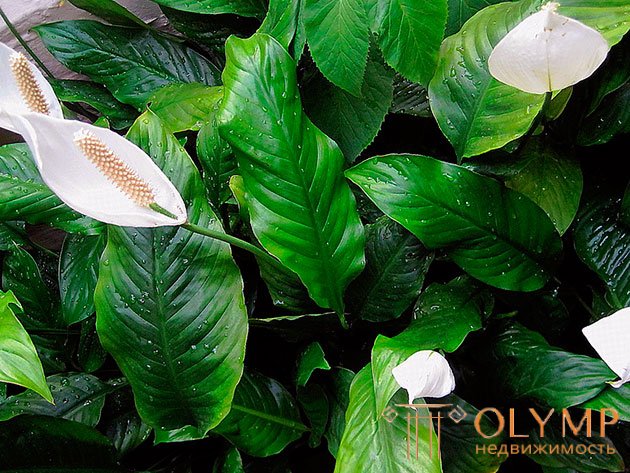
Spathiphyllum blooming, or flagolist - Spathiphyllum floribundum L. (family. Aroid). Homeland - tropical areas of the Americas. Perennial stemless flowering plant 50 cm tall with a short rhizome. Leaves are basal, ovate-lanceolate, 15–20 cm long, green with a lighter medium vein; lateral veins parallel to the central. The leaves are opaque at the bottom, articulated, vaginal at the base. Leaves of the same length. Small nondescript green flowers are collected in a not very large ear 6-8 cm in length and 2-5 cm in width, covered with a snow-white veil, slightly lagging behind the inflorescence. It is appreciated for long flowering and even cultivated for cutting. Cut flowers stand in the water for a long time. The plant is very thermophilic. Care is normal.
Currently in the United States launched a great variety - Mauno Loa. On one plant 20-25 inflorescences and more. Soft cream flowers are collected in an elegant direct ear up to 5 cm in height. Peduncle 25-35 cm long. The cover is snow-white, rounded, pointed to the top. Flowers emit a delicate scent. The first-class material for shear culture. It can be widely used as a decorative leafy and flowering plant for a variety of warm bright rooms.

Spathiphyllum Vallisi - Spathiphyllum vallisii L. (family. Aroid). Homeland - Colombia. It is small - up to 25-30 cm in height with a short rhizome plant. The leaves are dark green, lanceolate, on rather long petioles. The ear is cylindrical, thin, slim, snow-white blanket. Blooms profusely and for a long time. Good in composition and cut.
Both types of spathyllum seeds almost do not give and the only (so far) method of reproduction is the division of the bush into 2-3 parts. The output factor is small. Divided parts must have roots. They are planted in pots with a diameter of 12-13 cm in the substrate, which consists of peat, unground leaves, humus and sand (1: 1: 1: 1/2) with the addition of brick dust, charcoal, coarsely crushed bark (up to 10 % of the total prepared substrate). All this is necessary for better aeration and moisture capacity, pH in the range of 5-5.5. These species can be grown in hydroponic and ion-itopic cultures. Grows in expanded clay or gravel. During the period of growth and flowering mineral supplements are necessary once a decade at the rate of 1-3 g per 1 liter of water. In winter, fertilizing is given less frequently and in smaller doses. The optimum temperature for spatifillums is 25 ... 27 ° С, humidity is 85-90%. In the summer, they need to be shaded, ventilated and sprayed with water at room temperature.
Location
Plants photophilous, but in summer you need a pritenka. In winter, the temperature is reduced, but not lower than 16 ° C, despite the fact that their growth is possible at 12-14 ° C.
Lighting
Penumbra.
Watering
In summer, the soil should always be moderately wet.
Air humidity
High.
Humidity: additional information
From time to time you need to spray the plant. In winter, watering more moderately at room temperature - the plant during the period of rest will not damage the dry air.
Care
Plant care is the same as for anthuriums. Separated parts of the plant grow rapidly and bloom after 8 months. In spring and summer, fertilizing is done with mullein and mineral fertilizers. If after the transplantation the leaves wither, a sprinkling is necessary, several times a day. Watering of plants is carried out only after a clod of earth begins to dry from above.
Breeding
Plants propagate by division, less often by seeds. Rooted plants are planted in 9-centimeter pots. The composition of the land is as follows: leaf - 1 hour, peat - 1 hour, sod - 1/2 hour, sand - 1/2 hour. Damage to the roots should be avoided during transplantation and transshipment, as the plants wilt easily. After transplantation, abundant watering and spraying are necessary.
Transfer
Annually in the spring. The composition of the land is as follows: leaf - 1 hour, peat - 1 hour, sod - 1/2 hour, sand - 1/2 hour.
Что бы оставить комментарий войдите
Комментарии (0)